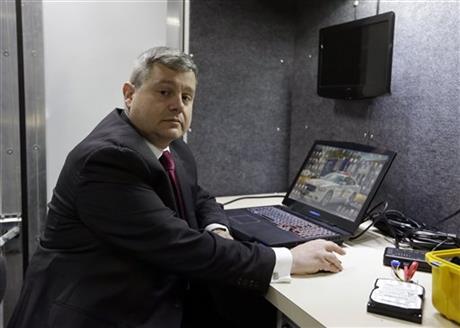
By CHARLES WILSON
In this Feb. 19, 2013, photo, Indiana State Police Lt. Chuck Cohen poses for a photo in a mobile crime lab in Indianapolis. The lab is used by an Indiana task force that is building a national reputation for aggressive pursuit of child pornographers worldwide. (AP Photo/Michael Conroy)
INDIANAPOLIS (AP) — In a cluttered office cubicle in a nondescript building on Indianapolis’ derelict east side, a man with rolled-up shirt sleeves scans email attachments of videos that depict startlingly young children being sexually tormented in ways that can make even federal judges weep.
Detective Kurt Spivey is trying to find the people who record or collect such images. He has 30 days to locate as many as he can. After that, the trail could go cold as the data on the hard drive dissolves.
Spivey is a 43-year-old police detective who parlayed his nine years in vice and experience with computers into a position on the city’s cybercrime unit. It’s part of central Indiana’s Internet Crimes Against Children task force, which has become one of the nation’s most aggressive and effective child pornography hunters, with a reach that extends around the globe.
“They are really cutting-edge,” said Francey Hakes, who worked for three years as a special assistant to the U.S. Attorney General overseeing child exploitation units in various agencies within the Justice Department. “I would say that most districts that have learned of some of the techniques and tactics used there have tried to model and adopt them as best they can.”
At first blush, Indiana isn’t a likely location for such a group. Though it has its share of violent crime, the state is better known for its hospitality, auto racing and love of basketball than as an international hotbed of perversion.
Yet in 2011, the latest year for which U.S. Department of Justice statistics are available, Indiana’s task force made 166 arrests for manufacturing, distributing or possessing child pornography. New York City’s task force made 16 arrests, and Chicago’s team made 71.
And Indiana did all this with about $100,000 less funding than New York City.
Much of the success of the Indiana team, which includes federal, state and local agencies, stems from the reach the Internet provides. The team also benefits from a rare level of cooperation among the law enforcement agencies that has largely eliminated turf wars.
That cooperation is essential as child pornography trafficking, which had largely been eliminated in the United States by the mid-1980s, has exploded, fueled by the Internet, social networking and digital technology that make it easy to produce and access.
“The thing with social networking is, no matter what your interest is, you can find people with the same interest or even more extreme interest … so by extension, you can feel normal,” said Indiana State Police Lt. Chuck Cohen, chief of the state’s Internet Crimes Against Children task force.
The National Center for Missing and Exploited Children says it reviewed 17.3 million images and videos of suspected child pornography in 2011. That’s four times more than 2007.
Assistant U.S. Attorney Steve DeBrota, who began pursuing child pornography cases in 1991 as a green federal prosecutor because no one else wanted them, said the technology can be a curse because it creates more avenues for sharing pornography.
But it’s also a blessing, because the Internet has no boundaries. So long as there’s a trail to follow, it doesn’t matter whether the investigator is in a rural farmhouse in Indiana or in a hut in Indonesia. The Indiana team has followed the cyber trail to suspects in the United Kingdom and Australia.
“Steve really pioneered the idea of what I call the spider-web investigation,” said Hakes, who runs a consulting firm based in Atlanta that advises police on child exploitation.
One such bust started Nov. 17, 2010, when a nondescript van pulled up in front of David Bostic’s home in Bloomington, Ind., and FBI agents, state troopers and local police officers swarmed to Bostic’s front door to serve a search warrant. Computer geeks using a mobile crime lab started digging through Bostic’s home computer, while others searched the house for DVDs or other evidence of sex crimes. The technique is called forensic triage, and Hakes says the Indianapolis-based unit pioneered it.
When searchers found images Bostic had deleted from his PC, interrogators immediately peppered Bostic with questions. He first admitted to collecting child porn, and then to producing it with children he babysat — some of them infants, none older than 5. He also told investigators he’d shared the images by email and other avenues with dozens of fellow collectors.
According to court records, the Indiana-based team then followed the trail that began on Bostic’s computer link by link through Internet Service Providers to an email account in the United Kingdom. Authorities there traced the account to a registered sex offender. While British authorities revoked his probation, investigators back in Indiana used his email contacts to track down his fellow collectors.
The case that started at Bostic’s house has resulted in 24 arrests — including some in Serbia and the UK. Bostic was sentenced to 315 years in prison in November 2011.
More importantly, DeBrota says, 24 children have been rescued.
Another Indiana case that was the largest at the time, with more than 50 arrests, spun off another investigation that led to 72 arrests, the biggest child porn bust in U.S. history.
Deputy U.S. Attorney Jay Exum of the Eastern District of North Carolina, who led that bust, credits DeBrota — one of a handful of prosecutors advising the attorney general on big child pornography investigations — and his team.
“You really need somebody who kind of steps into the darkness and stays there to fight. And that’s the kind of guy Steve is,” Exum said.



